What’s Near
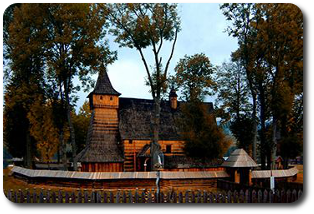 15th century St. Michael Archangel church in Debno is numbered among the highest-class monuments in Poland and represents a unique regional legacy of religious art and architecture. Its lavishly decorated interior, which features a beautiful triptych, gothic tabernacle and paintings which remarkably have kept their colours fast for over five centuries. The diverse and intricate composition, depicting anthropomorphic and zoomorphic figures, reflects influences from contemporary Polish court art. The Gothic figure of Saint Nicholas next to the tabernacle was sculpted in 1420. The beautiful crucifix, so-called Tree of Life, dates back to 1380. Legend says that Janosik, a hero of the Tatra people, often used to visit the church. Sightseeing isn’t possible as the church is only open during church services and is not accessible on rainy days due to high air humidity which is dangerous to the building and the interior fittings. The Church was included on the World Monuments Watch in 1996 and 1998 and the following year, the World Monuments Fund organisation researched and documented the conditions of the structure and the interior decorations as to develop conservation plans for the sanctuary.
15th century St. Michael Archangel church in Debno is numbered among the highest-class monuments in Poland and represents a unique regional legacy of religious art and architecture. Its lavishly decorated interior, which features a beautiful triptych, gothic tabernacle and paintings which remarkably have kept their colours fast for over five centuries. The diverse and intricate composition, depicting anthropomorphic and zoomorphic figures, reflects influences from contemporary Polish court art. The Gothic figure of Saint Nicholas next to the tabernacle was sculpted in 1420. The beautiful crucifix, so-called Tree of Life, dates back to 1380. Legend says that Janosik, a hero of the Tatra people, often used to visit the church. Sightseeing isn’t possible as the church is only open during church services and is not accessible on rainy days due to high air humidity which is dangerous to the building and the interior fittings. The Church was included on the World Monuments Watch in 1996 and 1998 and the following year, the World Monuments Fund organisation researched and documented the conditions of the structure and the interior decorations as to develop conservation plans for the sanctuary.
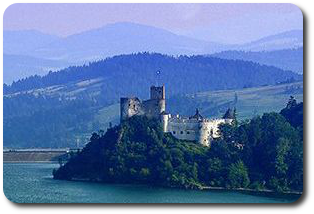 Niedzica Castle, also known as Dunajec Castle, is an important centre of Polish-Hungarian relations built in 1326 and developed into a popular tourist destination as a result of the construction of the dam on Dunajec river between 1975-1997. Sosny Glade, located between the Dunajec river and the road towards Lysa on the Dunajec, is a tourist settlement which features an area suitable for camping, a restaurant, two guest houses, a marina with rental, parking and ski a resort. The Jewish cemetery in Niedzica is located southeast of the village in the hamlet Podgłebokie and covers an area of 58 square meters. Despite the devastation during World War II, several gravestones from the late nineteenth and early twentieth century survived. The memorials are made of sandstone and have inscriptios in Hebrew.
Niedzica Castle, also known as Dunajec Castle, is an important centre of Polish-Hungarian relations built in 1326 and developed into a popular tourist destination as a result of the construction of the dam on Dunajec river between 1975-1997. Sosny Glade, located between the Dunajec river and the road towards Lysa on the Dunajec, is a tourist settlement which features an area suitable for camping, a restaurant, two guest houses, a marina with rental, parking and ski a resort. The Jewish cemetery in Niedzica is located southeast of the village in the hamlet Podgłebokie and covers an area of 58 square meters. Despite the devastation during World War II, several gravestones from the late nineteenth and early twentieth century survived. The memorials are made of sandstone and have inscriptios in Hebrew.
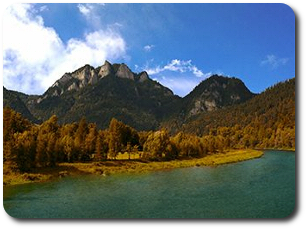 Undoubtedly one of Pieniny mountains’ biggest tourist attractions, where you can appreciate the beauty of the local National Park while cruising through the limestone gorge on traditional wooden rafts. Rafting season lasts from 1 April till 31 October every day except for two church holidays: Corpus Christi and the first day of Easter. Rafts set out from the rafting marina at Sromowce-Katy, where you can find a parking lot, exhibition pavilion of Pieniny National Park, Tourist Information Office, souvenir shops, a restaurant and ticket offices. Tickets needn’t be reserved, as they may be purchased upon arrival. There are two destination marinas:
Undoubtedly one of Pieniny mountains’ biggest tourist attractions, where you can appreciate the beauty of the local National Park while cruising through the limestone gorge on traditional wooden rafts. Rafting season lasts from 1 April till 31 October every day except for two church holidays: Corpus Christi and the first day of Easter. Rafts set out from the rafting marina at Sromowce-Katy, where you can find a parking lot, exhibition pavilion of Pieniny National Park, Tourist Information Office, souvenir shops, a restaurant and ticket offices. Tickets needn’t be reserved, as they may be purchased upon arrival. There are two destination marinas:
1. Szczawnica – approx. 18 km, 2 hours 15 min.
2. Krościenko – approx. 23 km, 2 hours 45 min.
Rafts depart after picking up a minimum of 10 people. additionally, there is an option of hiring a pontoon for the more adventurous individuals.
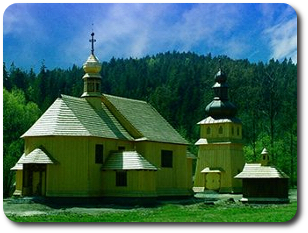 The Orava Ethnographic Park Museum, which was opened in 1955, is a centre of Oravan history and culture. There are open-air events, full of singing, dancing, folk art and craft, which recreate the village life as it once was. The largest annual events include the “Blueberry Day”, which features shows of folk craft such as smithing, embroidery, painting, pottery, tailoring, and such crafts. There are also song and dance performances and competitions for children and adults. Apart from visiting, one may also learn a traditional craft at the Museum. In groups of about 20 people, under the supervision of an instructor, you may participate in the flax working process, making flour and bread, painting on glass, making paper decorations or rag-dolls, as well as learning to sing regional songs. Definately worth a visit, winter or summer, but bring an umbrella just in case, as the museum is situated right on the side of Babia Gora, which is well known for sudden changes of weather.
The Orava Ethnographic Park Museum, which was opened in 1955, is a centre of Oravan history and culture. There are open-air events, full of singing, dancing, folk art and craft, which recreate the village life as it once was. The largest annual events include the “Blueberry Day”, which features shows of folk craft such as smithing, embroidery, painting, pottery, tailoring, and such crafts. There are also song and dance performances and competitions for children and adults. Apart from visiting, one may also learn a traditional craft at the Museum. In groups of about 20 people, under the supervision of an instructor, you may participate in the flax working process, making flour and bread, painting on glass, making paper decorations or rag-dolls, as well as learning to sing regional songs. Definately worth a visit, winter or summer, but bring an umbrella just in case, as the museum is situated right on the side of Babia Gora, which is well known for sudden changes of weather.
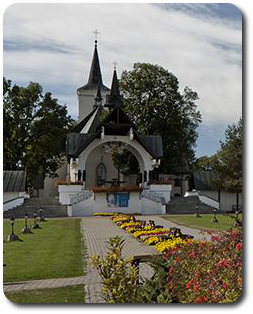 The Marian Sanctuary in Ludzmierz is home to Our Lady of Ludzmierz, known as the Shepherdess of Podhale and is the oldest Roman Catholic parish in Podhale with history dating back to the 13th century. In 1234 Teodor Gryfita began building a simple wooden church after obtaining permission from the bishop of Kraków and a monastery was raised soon after with the help of Cisterian monks who, known for their agricultural skills, were brought to encourage settlement in the uninhabited area. The buildings were burned down in 1796 but by mid -19th century has come under the care of diocesan priests and, after dismanting the old wooden structure, a new sanctuary was built and the figurine of Our Lady became the main altarpiece. The sanctuary was declared a minor basilica a few years after a visit by John Paul II in 1997, almost 30 years after an incident in which the statue of Our Lady slipped during a ceremony and the then a bishop caught a scepter which had falled out of the statue’s grasp. The scene became a well known story and was treated as a prophecy of the future Pope’s selection as the head of the church. The statue dates back to the 15th century and attracts masses of pilgrims to the shrine each year, a devotion which can be traced back to the outmigration of the highlander community out of their native Carpathian homeland.
The Marian Sanctuary in Ludzmierz is home to Our Lady of Ludzmierz, known as the Shepherdess of Podhale and is the oldest Roman Catholic parish in Podhale with history dating back to the 13th century. In 1234 Teodor Gryfita began building a simple wooden church after obtaining permission from the bishop of Kraków and a monastery was raised soon after with the help of Cisterian monks who, known for their agricultural skills, were brought to encourage settlement in the uninhabited area. The buildings were burned down in 1796 but by mid -19th century has come under the care of diocesan priests and, after dismanting the old wooden structure, a new sanctuary was built and the figurine of Our Lady became the main altarpiece. The sanctuary was declared a minor basilica a few years after a visit by John Paul II in 1997, almost 30 years after an incident in which the statue of Our Lady slipped during a ceremony and the then a bishop caught a scepter which had falled out of the statue’s grasp. The scene became a well known story and was treated as a prophecy of the future Pope’s selection as the head of the church. The statue dates back to the 15th century and attracts masses of pilgrims to the shrine each year, a devotion which can be traced back to the outmigration of the highlander community out of their native Carpathian homeland.





